for baritone and piano
duration c. 00:03:50
Commissioned by the Source Song Festival for their 5th anniversary
Peruse and purchase score here
Text:
A Purple Ravelling – Athena Kildegaard, from Course (2018)
Anyhow, with no warning, the radio
powdered away to a low buzz, a pewter
undertow of sound, then with one loud
rasp across the sky, a shimmer of light
pure as anodyne, the car went silent
lost in a high-pressure zone, then a low,
enough to turn the sky inside out,
ravel it before my very eyes. I drove on
along the section line, corn in rows
vary-less as if someone had crossed the road
enervated and mathematical and had
lost themselves in this parallel universe.
Lost myself, anyhow, in watching across
instant repetition, row, row, row, rain
nervously slanting across the windshield
going nowhere, going right on down the road.
About the Piece:
This song was commissioned by the Source Song Festival for the opening concert of their fifth annual festival. A requirement of the commission was for the song to relate to Minnesota in some way. In this case, I have set the text of Minnesota poet Athena Kildegaard, whom I became aware of through accompanying her daughter, soprano Anika Kildegaard, at the piano.
The poem is an acrostic: the first letters of each line, read from top to bottom, spell a phrase from Emily Dickinson’s poem #219. It should be noted that an acrostic is a visual device: the reader of the poem perceives the acrostic through the same sense they use to experience the poem, which is what makes it effective. An aural acrostic is not experienced by the listener unless they have the score and are made aware of the process behind it ahead of time.
I wanted to reflect the acrostic in my setting, since it is the structural backbone of the poem. To do this, I ran the phrase “A Purple Ravelling” through a musical cipher, which assigns a letter of the musical alphabet to each letter of the Latin alphabet. Many composers have used ciphers throughout history; I chose to use Arthur Honegger’s cipher due to its inclusion of chromatic notes and for my personal bias of liking his music. I used the resultant pitches to set the first word or syllable of each line. These pitches reduce to a seven-note set, which, in addition to opening and closing the piece, informs intervallic and motivic content throughout the work.
I could have chosen to use a cipher of my own devising, but decided not to, since I thought it was important to have an outside stricture controlling the setting, just as the Emily Dickinson poem controls Athena’s poem. Furthermore, this idea of a force outside of one’s control is present as the storm in the poem, which causes the narrator to enter a reverie of sorts.
The text consists of three sentences, alluding to the ternary form that so many songs utilize. I saw the first sentence as being thematically distinct from the second two, so my setting does not reflect ABA form but loosely resembles a recitative and aria. I chose to favor text painting and sonic imagery over trying to contort the poem into repetitive, tuneful phrases; I believe this best serves the mercurial nature of the original text.
Performance History:
| Date | Time | Location | Event | Performers |
|---|---|---|---|---|
| 8.6.18 | 8:00pm | Westminster Hall, Minneapolis, MN | Source Song Festival | Alan Dunbar, baritone; Mary Jo Gothmann, piano |
